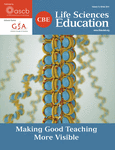Abstract
Phylogenetic trees are widely used visual representations in the biological sciences and the most important visual representations in evolutionary biology. Therefore, phylogenetic trees have also become an important component of biology education. We sought to characterize reasoning used by introductory biology students in interpreting taxa relatedness on phylogenetic trees, to measure the prevalence of correct taxa-relatedness interpretations, and to determine how student reasoning and correctness change in response to instruction and over time. Counting synapomorphies and nodes between taxa were the most common forms of incorrect reasoning, which presents a pedagogical dilemma concerning labeled synapomorphies on phylogenetic trees. Students also independently generated an alternative form of correct reasoning using monophyletic groups, the use of which decreased in popularity over time. Approximately half of all students were able to correctly interpret taxa relatedness on phylogenetic trees, and many memorized correct reasoning without understanding its application. Broad initial instruction that allowed students to generate inferences on their own contributed very little to phylogenetic tree understanding, while targeted instruction on evolutionary relationships improved understanding to some extent. Phylogenetic trees, which can directly affect student understanding of evolution, appear to offer introductory biology instructors a formidable pedagogical challenge.



